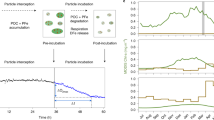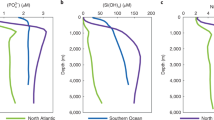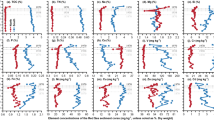Abstract
Trace metals shape both the biogeochemical functioning and biological structure of oceanic provinces. Trace metal biogeochemistry has primarily focused on modes of external supply of metals from aeolian, hydrothermal, sedimentary and other sources. However, metals also undergo internal transformations such as abiotic and biotic retention, recycling and remineralization. The role of these internal transformations in metal biogeochemical cycling is now coming into focus. First, the retention of metals by biota in the surface ocean for days, weeks or months depends on taxon-specific metal requirements of phytoplankton, and on their ultimate fate: that is, viral lysis, senescence, grazing and/or export to depth. Rapid recycling of metals in the surface ocean can extend seasonal productivity by maintaining higher levels of metal bioavailability compared to the influence of external metal input alone. As metal-containing organic particles are exported from the surface ocean, different metals exhibit distinct patterns of remineralization with depth. These patterns are mediated by a wide range of physicochemical and microbial processes such as the ability of particles to sorb metals, and are influenced by the mineral and organic characteristics of sinking particles. We conclude that internal metal transformations play an essential role in controlling metal bioavailability, phytoplankton distributions and the subsurface resupply of metals.
This is a preview of subscription content, access via your institution
Access options
Access Nature and 54 other Nature Portfolio journals
Get Nature+, our best-value online-access subscription
$29.99 / 30 days
cancel any time
Subscribe to this journal
Receive 12 print issues and online access
$259.00 per year
only $21.58 per issue
Buy this article
- Purchase on Springer Link
- Instant access to full article PDF
Prices may be subject to local taxes which are calculated during checkout



Similar content being viewed by others
References
Boyd, P. W. et al. Mesoscale iron enrichment experiments 1993–2005: synthesis and future directions. Science 315, 612–617 (2007).
Moore, C.M. et al. Processes and patterns of oceanic nutrient limitation. Nat. Geosci. 6, 701–710 (2013).
Cullen, J. T. & Sherrell, R. M. Effects of dissolved carbon dioxide, zinc, and manganese on the cadmium to phosphorus ratio in natural phytoplankton assemblages. Limnol. Oceanogr. 50, 1193–1204 (2005).
Koch, F. et al. The effect of vitamin B12 on phytoplankton growth and community structure in the Gulf of Alaska. Limnol. Oceanogr. 56, 1023–1034 (2011).
Jickells, T. D. & Moore. C. M. The importance of atmospheric deposition for oceanic productivity. Annu. Rev. Ecol. Evol. Syst. 46, 481–501 (2015).
Resing, J. A. et al. Basin-scale transport of hydrothermal dissolved metals across the South Pacific Ocean. Nature 523, 200–203 (2015).
Fitzsimmons, J. N. et al. Daily to decadal variability of size-fractionated iron and iron-binding ligands at the Hawaii Ocean Time-series Station ALOHA. Geochim. Cosmochim. Acta 171, 303–324 (2015).
Twining, B. S., Rauschenberg, S., Morton, P. & Vogt, S. Metal contents of phytoplankton and labile particulate material in the North Atlantic Ocean. Prog. Oceanogr. 137, 261–293 (2015).
Karl, D. M. et al. in Ocean Biogeochemistry: The Role of the Ocean Carbon Cycle in Global Change (ed. Fasham, M. J. R.) Ch. 11 (Springer, 2003).
Weber, T., Cram, J. A., Leung S. W., DeVries T. & Deutsch C. Deep ocean nutrients imply large latitudinal variation in particle transfer efficiency. Proc. Natl Acad. Sci. USA 113, 8606–8611 (2016).
Bruland, K. W. & Lohan, M. C. in The Oceans and Marine Geochemistry: Treatise on Geochemistry (ed. Elderfield, H.) Ch. 6 (Elsevier, 2003).
Zehr, J. P. & Ward, B. B. Nitrogen cycling in the ocean: new perspectives on processes and paradigms. Appl. Environ. Microbiol. 68, 1015–1024 (2002).
Morel, F. M. M. & Price, N. M. The biogeochemical cycles of trace metals in the oceans. Science 300, 944–947 (2003).
Quigg, A., Irwin, A. J. & Finkel, Z. V. Evolutionary inheritance of elemental stoichiometry in phytoplankton. Proc. R. Soc. Lond. B 278, 526–534 (2011).
Singh, A., Baer, S. E., Riebesell, U., Martiny, A. C. & Lomas, M. W. C : N : P stoichiometry at the Bermuda Atlantic Time-series Study station in the North Atlantic Ocean. Biogeosciences 12, 6389–6403 (2015).
Martiny, A. C., Kathuria, S. K. & Berube P. Widespread metabolic potential for nitrite and nitrate assimilation among Prochlorococcus ecotypes. Proc. Natl Acad. Sci. USA 106, 10787–10792 (2009).
Boyd, P. W. & Ellwood, M. J. The biogeochemical cycle of iron in the ocean. Nat. Geosci. 3, 675–682 (2010).
Boyd, P. W. et al. Microbial control of diatom bloom dynamics in the open ocean. Geophys. Res. Lett. 39, L18601 (2012).
Bowie. A. R. et al. Iron budgets for three distinct biogeochemical sites around the Kerguelen Archipelago (Southern Ocean) during the natural fertilisation study, KEOPS-2. Biogeosciences 12, 4421–4445 (2015).
Fitzsimmons, J. N., Bundy, R. M., Al-Subiai, S. N., Barbeau, K. A. & Boyle, E. A. The composition of dissolved iron in the dusty surface ocean: an exploration using size-fractionated iron-binding ligands. Mar. Chem. 173, 125–135 (2015).
Buck, K. N., Sohst B. & Sedwick, P. N. The organic complexation of dissolved iron along the US GEOTRACES (GA03) North Atlantic Section. Deep-Sea Res. PT II. 116, 152–165 (2015).
Aumont, O., Ethé, C., Tagliabue, A., Bopp, L. & Gehlen, M. PISCES-v2: an ocean biogeochemical model for carbon and ecosystem studies. Geosci. Model Dev. 8, 2465–2513 (2015).
Tagliabue, A. et al. How well do global ocean biogeochemistry models simulate dissolved iron distributions? Global Biogeochem. Cy. 30, GB005289 (2016).
Adly, C. L. et al. Response of heterotrophic bacteria to mesoscale iron enrichment in the northeast subarctic Pacific Ocean. Limnol. Oceanogr. 60, 136–148 (2015).
Bundy R. M., Jiang, M., Carter, M. & Barbeau, K. A. Iron-binding ligands in the southern California current system: mechanistic studies. Front. Mar. Sci. 3, 27 (2016).
Lamborg, C. H., Buesseler, K. O. & Lam, P. J. Sinking fluxes of minor and trace elements in the North Pacific Ocean measured during the VERTIGO program. Deep-Sea Res. PT II 55, 1564–1577 (2008).
Sedwick, P. N. et al. Iron in the Sargasso Sea (Bermuda Atlantic Time-series Study region) during summer: eolian imprint, spatiotemporal variability, and ecological implications. Global Biogeochem. Cy. 19, GB4006 (2005).
Boyd, P. W. et al. Why are biotic iron pools uniform across high- and low-iron pelagic ecosystems? Global Biogeochem. Cy. 29, 1028–1043 (2015).
Twining, B. S. et al. Differential remineralization of major and trace elements in sinking diatoms. Limnol. Oceanogr. 59, 689–704 (2014).
Tagliabue, A., Sallee, J.-B., Bowie, A. R., Levy, M., Swart, S. & Boyd, P. W. Surface-water iron supplies in the Southern Ocean sustained by deep winter mixing. Nat. Geosci. 7, 314–320 (2014).
Boyd, P. W. & Tagliabue, A. Using the L* concept to explore controls on the relationship between paired ligand and dissolved iron concentrations in the ocean. Mar. Chem. 173, 52–66 (2015).
Bonnain, C., Breitbart, M & Buck, K. N. The ferrojan horse hypothesis: iron-virus interactions in the ocean. Front. Mar. Sci. 3, 82 (2016).
Wells, M. L., Mayer, L. M., Donard, O. F. X., de Souza Sierra, M. M. & Ackelson, S. G. The photolysis of colloidal iron in the oceans. Nature 353, 248–250 (1991).
Barbeau, K. A. & Moffett, J. W. Dissolution of iron oxides by phagotrophic protists: using a novel method to quantify reaction rates. Environ. Sci. Technol. 32, 2969–2975 (1998).
Rubin, M., Berman-Frank, I. & Shaked, Y. Dust-and mineral-iron utilization by the marine dinitrogen-fixer Trichodesmium. Nat. Geosci. 4, 529–534 (2011).
Hopkinson, B. M. & Barbeau, K. Interactive influences of iron and light limitation on phytoplankton at subsurface chlorophyll maxima in the eastern North Pacific. Limnol. Oceanogr. 53, 1303–1318 (2008).
Kirchman D. L. Microbial ferrous wheel. Nature 383, 303–304 (1996).
Twining, B. S. & Baines S.B. The trace metal composition of marine phytoplankton. Annu. Rev. Mar. Sci. 5, 191–215 (2013).
Marchetti, A. et al. Ferritin is used for iron storage in bloom-forming marine pennate diatoms. Nature 457, 467–470 (2009).
Lis, H., Shaked, Y., Kranzler, C. Keren N. & Morel, F. M. M. Iron bioavailability to phytoplankton: an empirical approach. The ISME Journal 9, 1003–1013 (2015).
Sunda W. G. & Huntsman S. A. Iron uptake and growth limitation in oceanic and coastal phytoplankton. Mar. Chem. 50, 189–206 (1995).
Melton, C. D., Swanner, E. D., Behrens, S., Schmidt C. & Kappler, A. The interplay of microbially mediated and abiotic reactions in the biogeochemical Fe cycle. Nat. Rev. Micro. 12, 797–808 (2014).
Boyd P. W. et al. FeCycle: attempting an iron biogeochemical budget from a mesoscale SF6 tracer experiment in unperturbed low iron waters. Global Biogeochem. Cy. 19, GB002494 (2005).
Sarthou, G. et al., The fate of biotic iron during a phytoplankton bloom induced by natural fertilization: Impact of copepod grazing. Deep-Sea Res. PT II 55, 734–751 (2008).
Smith, D. C., Simon, M., Alldredge, A. L. & Azam F. Intense hydrolytic enzyme activity on marine aggregates and implications for rapid particle dissolution. Nature 359, 139–142, (1992).
Frew, R. D. et al. Particulate iron dynamics during FeCycle in subantarctic waters southeast of New Zealand. Global Biogeochem. Cy. 20, GB002558 (2006).
Bidle, K. D. & Azam, F. Accelerated dissolution of diatom silica by marine bacterial assemblages. Nature 397, 508–512 (1999).
Clegg, S. L. & Whitfield, M. A generalized model for the scavenging of trace metals in the open ocean—II. Thorium scavenging. Deep-Sea Res. 38, 91–120 (1991).
Boyd, P. W. & Trull, T. W. Understanding the export of biogenic particles in oceanic waters: is there consensus? Prog. Oceanogr. 72, 276–312 (2007).
Acknowledgements
The authors thank G. Jackson (Texas A&M University) and T. Kiørboe (Technical University of Denmark) for the provision of unpublished data/video footage. The authors acknowledge the role of collaborations with David Hutchins, Sylvia Sander, Robert Strzepek and Steve Wilhelm in developing this Perspective. The sinking particles presented in Supplementary Fig. 2c were collected by Z. Baumann (University of Connecticut) and analysed with the assistance of D. Ohnemus (Bigelow Laboratory for Ocean Sciences). This analysis used resources of the Advanced Photon Source, a US Department of Energy (DOE) Office of Science User Facility operated for the DOE Office of Science by Argonne National Laboratory under Contract No. DE-AC02-06CH11357. Support was provided by Australian Research Council Australian Laureate Fellowship project FL160100131 and Antarctic Climate and Ecosystems Cooperative Research Centre funding to P.W.B., an Australian Research Council Discovery Project DP130100679 to M.J.E. and P.W.B. B.S.T. was supported by US National Science Foundation grant OCE-1232814. Model simulations by A.T. are supported by N8 HPC Centre of Excellence, provided and funded by the N8 consortium and EPSRC (Grant No. EP/K000225/1).
Author information
Authors and Affiliations
Contributions
P.W.B., M.J.E., A.T. and B.S.T. contributed equally to conceiving and developing the material presented, and to writing the paper.
Corresponding author
Ethics declarations
Competing interests
The authors declare no competing financial interests.
Supplementary information
Supplementary Information
Supplementary Figures and Tables (PDF 853 kb)
Supplementary Video 1
Animation of heterotrophic microflagellatesattached to a particle and feeding on free-living and particle-attached bacteria. The particle was created from a latex bead coated in an organic substrate to promote microbial colonisation. The video reveals that the surface of such biogenic particles in the ocean is likely a 'hotspot' of iron recycling and release, the balance of which is dependent on the small scale trace metal chemistry as outlined in Figure 3 and S-Figure 2 (Courtesy of Thomas Kiørboe, Technical University of Denmark). (WMV 4026 kb)
Rights and permissions
About this article
Cite this article
Boyd, P., Ellwood, M., Tagliabue, A. et al. Biotic and abiotic retention, recycling and remineralization of metals in the ocean. Nature Geosci 10, 167–173 (2017). https://doi.org/10.1038/ngeo2876
Received:
Accepted:
Published:
Issue Date:
DOI: https://doi.org/10.1038/ngeo2876
This article is cited by
-
Authigenic mineral phases as a driver of the upper-ocean iron cycle
Nature (2023)
-
Persistent equatorial Pacific iron limitation under ENSO forcing
Nature (2023)
-
Pack-ice seals contribute to biological transfers of iron in the Southern Ocean
Polar Biology (2023)
-
Siderophores as an iron source for picocyanobacteria in deep chlorophyll maximum layers of the oligotrophic ocean
The ISME Journal (2022)
-
Petrobactin, a siderophore produced by Alteromonas, mediates community iron acquisition in the global ocean
The ISME Journal (2022)



